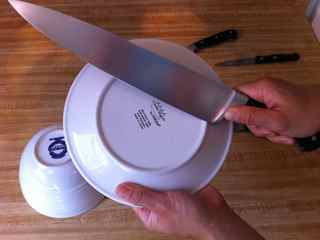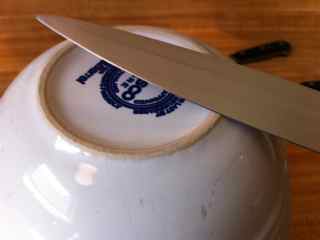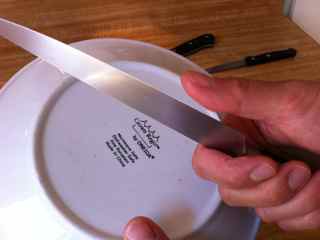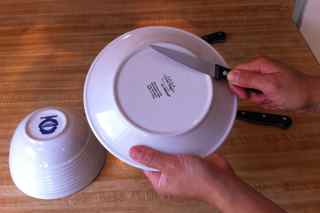 Next to my hands, my knives are the most important tools in my kitchen. And because they are so important, my knives get the utmost in attention and care. This means a few things that I believe are Cardinal Rules for all your cutlery: I ALWAYS wash them by hand; I NEVER put them in the bottom of the sink; I NEVER scrape the blade on my cutting board and most importantly, I ALWAYS make sure my knives are sharp.
Next to my hands, my knives are the most important tools in my kitchen. And because they are so important, my knives get the utmost in attention and care. This means a few things that I believe are Cardinal Rules for all your cutlery: I ALWAYS wash them by hand; I NEVER put them in the bottom of the sink; I NEVER scrape the blade on my cutting board and most importantly, I ALWAYS make sure my knives are sharp.
The last part is important because a sharp knife will allow you to work better and faster. And contrary to popular belief, you injure yourself less with a sharp knife. With that in mind, I have a whetstone and a steel as part of my kitchen equipment. Now, the whetstone isn’t necessary if you get your knives sharpened professionally at a knife or kitchenware store but the steel is necessary for everyone who owns a knife. Despite the name, a knife sharpening steel doesn’t sharpen your knife; instead it helps hone the blade of your knife to a true edge. Honing is the process of pushing the metal on the edge back into alignment. If you ever watch a knifesmith sharpen a knife, they will start with a whetstone to remove some metal on the blade which forms a new edge and straightens the existing metal on blade. The knifesmith then finishes the knife on a steel to clean up the blade by smoothing out the irregularities that occurred while it was on the whetstone. So now you know how knives are sharpened.
While it would be great if everyone owned both a whetstone and a steel, I know that’s not possible or necessary. So with that, I would recommend that you at least go out and buy a steel. But, in the meantime, if you don’t have a steel or find yourself in a kitchen that doesn’t have one, reach for a dinner plate. A ceramic plate or even a bowl has an unglazed ring on the bottom that makes it ideal as an impromptu steel. Simply take your knife and angle it at about 20-25 degrees to the edge and run it along the ring a few times on each side. I learned this trick from French chef Jacques Pepin years ago when I saw him at a book signing and I’ve always used this whenever I’m without my steel. This works because the grittiness of the unglazed part of your plate or bowl can smooth the irregularities in your knife and help maintain the edge similar to the steel.












Comments
How to Segment Citrus Fruits | Samantha Food Geek
Posted February 08, 2012[...] [...]
samantha
Posted November 25, 2011Thanks so much for your kind comments. Glad you found this helpful!
Leave a reply